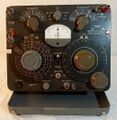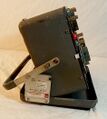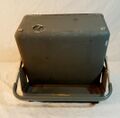1650-A
The General Radio 1650A is a portable impedance bridge introduced in 1959. It was succeeded by the 1650-B in 1968.
The 1650 has an "Orthonull" feature, which is a mechanical link driving the DQ dial from the CRL dials through a friction clutch. It helps avoid the "sliding null" insenswhen measuring components with high losses, the Orthonull feature locks the DQ dial to the CRL dial with a friction clutch. If properly adjusted, turning the CRL dial will also turn the DQ dial. But, turning the DQ dial will not turn the CRL dial. The manual describes the feature in detail, but because I didn't grasp it at first, I'll say it again. Using Orthonull, the DQ dial turns by itself in the usual fashion. The CRL dial will also drive the DQ dial at the same time. Balance the bridge in the usual way for the deepest null. Friction will be a bit higher, but the sliding null problem will be entirely avoided, thanks to Henry's very clever invention.
Specifications
- Capacitance: 1 pF to 1100 μF in 7 ranges.
- Inductance: 1 μH to 1100 H in 7 ranges
- Resistance: 1 mΩ milliohm to 11 MΩ in 8 ranges
- D: (series capacitance) 0.001 to 1 at 1 kHz, (parallel capacitance) 0.1 to 50 at 1 kHz
- Q: (series inductance) 0.02 to 10 at 1 kHz, (parallel inductance) 1 to 1000 at 1 kHz
- Basic accuracy: ±1% of full scale, ±5% for dissipation factor
- Internal oscillator: 1 kHz ±2%
- Frequency range: 20 Hz to 20 kHz (to 100 kHz with reduced accuracy)
Manuals
- General Radio 1650-A Impedance Bridge Manual, 1964 version (OCRed)
- General Radio 1650-A Impedance Bridge Manual, 1960 version (OCRed)
Links
- The GR 1650-A & 1650-B Portable Bridges @ conradhoffman.com
- US Patent 2872639, Henry P Hall, Electrical bridge and method. Filed Oct. 10, 1956; Granted Feb. 3, 1959 (describing the Orthonull feature)
- US Patent 2966257, Henry C Littlejohn, Instrument carrying case. Filed Nov. 5, 1959; Granted Dec. 27, 1960
- Henry P. Hall, A New Universal Impedance Bridge. GENERAL RADIO EXPERIMENTER Volume 33, No. 3, March 1959, page 3.
- IET Labs Application Note, Henry Hall: Father of the Digibridge
Pictures
Internal












